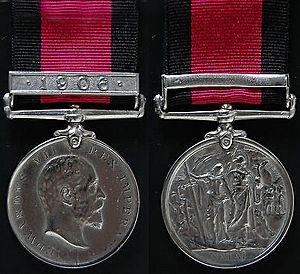Natal Native Rebellion Medal facts for kids
Quick facts for kids Natal Native Rebellion Medal |
|
|---|---|
 |
|
| Country | |
| Type | Military campaign medal |
| Eligibility | Military and police forces |
| Awarded for | Campaign service |
| Campaign(s) | Bambatha Rebellion, 1906 |
| Clasps | 1906 |
| Statistics | |
| Established | 1907 |
| Order of wear | |
| Next (higher) | Tibet Medal |
| Next (lower) | India General Service Medal (1909) |
Ribbon bar |
|
The Natal Native Rebellion Medal was a special award from the British government. It was created in 1907. This medal was given to people who served in Natal. They helped during a Zulu uprising in 1906. This revolt was against British rule and new taxes. A special "1906 Clasp" was added to the medal. This clasp was for those who served for more than fifty days.
Contents
The Bambatha Rebellion: Why it Happened
After the Second Boer War, it was hard for British bosses in Natal to find enough Zulu farm workers. Many Zulu men preferred to work in the gold mines. To make more Zulu men work on farms, the Natal government added a new tax. This was a £1 "head tax" for each person. It was on top of an older "hut tax" for homes.
This new tax caused a revolt. Chief Bambatha kaMancinza led the uprising. He was a leader of the amaZondi clan of the Zulu people. They lived in the Mpanza Valley near Greytown. The revolt began in February 1906. Two British tax collectors were killed near Richmond.
How the Rebellion Unfolded
The government declared martial law. This meant the army took control. Bambatha started using guerrilla tactics. He attacked quickly and then hid. He used the Nkandla forest as his base. The revolt continued for some time. Finally, colonial troops surrounded the rebels. This happened at Mome Gorge.
Between 3,000 and 4,000 Zulus were killed during the revolt. Some Zulus even fought for the Natal government. Over 7,000 people were put in prison. Many others faced harsh penalties. King Dinuzulu kaCetshwayo was also arrested. He was found guilty of treason and jailed for four years. He had quietly supported Bambatha.
Creating the Medal
The Natal Native Rebellion Medal was officially approved. King Edward VII gave his permission on 9 May 1907. The "1906 Clasp" was also approved at this time. The Natal Government issued this medal. It was for service during the Bambatha Rebellion in 1906.
Who Received the Medal?
To get the medal, a soldier or policeman had to serve in the field. They needed to serve for at least twenty days. This service had to be between 11 February and 3 August 1906. If they served for fifty days or more, they also received the "1906 Clasp".
In total, 9,979 medals were given out. Most of these (8,045) had the clasp. The rest (1,934) did not. Most recipients were from Natal's military and police forces. Some volunteers from the Transvaal Colony also received medals (546). A few troops from the Cape of Good Hope (70) got them too.
Interestingly, twenty members of the Indian Ambulance Corps received the medal. They did not get the clasp. One of these was Mahatma Gandhi. He helped create this corps. He also served as its leader. No regular British Army units were involved in this campaign. So, they did not receive this medal.
What the Medal Looks Like
The Goldsmiths and Silversmiths Company in London made the medal. The Natal Government asked them to design it. It is a silver disk. It is about 36 millimeters (1.4 inches) wide.
- Obverse (Front)
The front of the medal shows King Edward VII's head. He is facing to the right. Around the edge, it says "EDWARDVS VII REX IMPERATOR". This means "Edward VII King Emperor".
- Reverse (Back)
The back of the medal shows two figures. One is Britannia, a symbol of Britain. The other is Natalia, a symbol of Natal. They are holding a large sword. They stand on a pile of native weapons. In the background, there is a landscape. You can see Zulu men and huts. A sunrise is behind them. The word "NATAL" is at the bottom.
- Clasp
The clasp is a small bar attached to the ribbon. It simply shows the year "• 1906 •".
- Naming
The name of the person who received the medal was written on its edge. Most names were stamped in block letters. Medals for officers usually had their names engraved.
- Ribbon
The ribbon is 32 millimeters (1.3 inches) wide. It is crimson (a deep red). It has black edges, about 7 millimeters (0.3 inches) wide.
How Medals Are Worn
Medals are worn in a specific order. This is called the "order of wear". Campaign medals are grouped together. They are worn after the Queen's Medal for Chiefs. They are worn before the Polar Medals. The order depends on when the campaign happened.
Order of Wear in South Africa
On 6 April 1952, South Africa created its own military awards. These new South African awards are worn before most older British medals. The only exception is the Victoria Cross. It is still worn first. Among British campaign medals for South Africans, the Natal Native Rebellion Medal fits in like this:
- It is worn after the King's South Africa Medal.
- It is worn before the 1914–15 Star.

